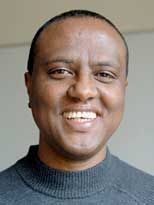In the small southern Ethiopian town where Akalu Tefera grew up, mathematics and physics textbooks were scarce. High school students who were as inspired by their teachers as he was borrowed their teachers' books.
Tefera, who has been named a Martin Luther King Jr. Visiting Professor for 2006-2007, now passes along his love for mathematics to others. He enjoys teaching mathematics at many levels--just as he used to help his classmates in Ethiopia--and has mentored undergraduate students in cutting-edge research.
Despite the fact that Tefera did not attend one of the elite private schools in the capital, he did manage to "pass through the needle's eye" as one of only a few thousand out of more than 100,000 students to pass the rigorous exam for admittance to Addis Ababa University, where he earned undergraduate and graduate degrees. He earned his Ph.D. degree from Temple University.
Tefera, associate professor of mathematics at Grand Valley State University in Allendale, Mich., specialized in the branch of mathematics called combinatorics, which studies collections of objects that meet certain criteria. An example of a combinatorial problem is: What is the number of possible ways to order a deck of 52 playing cards? The answer involves multiplying 51 digits and arriving at a number 68 digits long.
Besides solving problems, combinatorics is about theory building.
Tefera works on software that facilitates mathematical expressions in symbolic form. His work in computer algebra has resulted in software packages that have useful applications in mathematics, in particular, to computer-generated proofs of combinatorial and integral identities.
"Research and exploration of algorithmic techniques used in computer-aided discovery and proof of mathematical theorems has been gaining a lot of momentum over the past decade," he said. "Some mathematical problems involve determining the number of different ways certain things can be done and finding a simple formula for doing so.
"One of the exciting discoveries in the early '90s was the introduction of a method by which the computer can prove large classes of identities using an elegant algorithmic checking procedure. For example, in the summer of 2005, I helped a student study a special class of sums and summation algorithms. Using these algorithms cleverly, the student was able to solve challenging and new problems that involve combinatorial identities," he said.
Tefera is energized by working with undergraduates. "I believe an exciting undergraduate research project is a key factor for cultivating and retaining student interest in pursuing advanced studies in mathematics," he said.
"I also like to work on research problems that stem from my classroom teaching experience and that enhance my classroom teaching," he said. "For example, I ask questions based on students' mathematical mistakes and misconceptions, such as, 'We know that this does not work in general, so for what class of objects does it work? Can we characterize those objects for which this generally wrong statement will be true?'"
While it may seem counterintuitive to dwell on mistakes, Tefera has found that mistakes have led to interesting problems. "The research problems and results are very interesting and exciting," he said.
A version of this article appeared in MIT Tech Talk on May 2, 2007 (download PDF).






